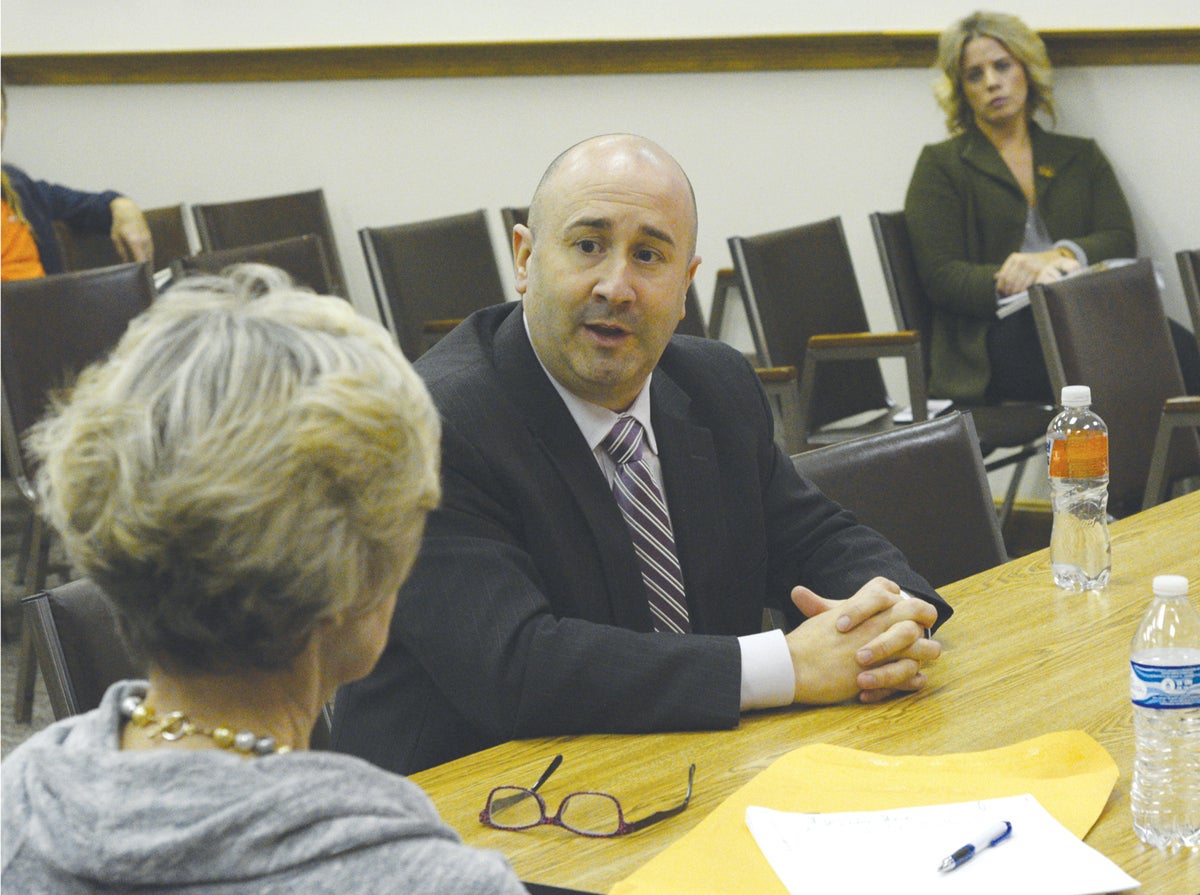Pensions, revenue top cities’ issues in Frankfort
Published 10:02 am Thursday, January 23, 2020

- Kentucky League of Cities Executive Director and CEO James D. "J.D." Chaney answers a question from Commissioner Kitty Strode Tuesday. (Photo by Randy Patrick)
How to fix the state’s pension system for city employees and allow municipalities new ways of raising revenue were among the topics covered by Kentucky League of Cities Executive Director and CEO James D. Chaney in his report Tuesday to the Winchester Board of Commissioners.
The County Employees Retirement System remains a major concern despite efforts by state legislators in recent years to provide more funding for public employee pension funds that are part of the Kentucky Retirement Systems.
Mayor Ed Burtner said the city is now paying about 40 percent of city employees’ salaries in CERS, which covers not only county workers but other local government employees as well, and that contribution could eventually be as high as 60 percent.
“It’s just not sustainable,” Burtner said Wednesday. “There are only two things we can do. We can drastically cut services, or we can raise taxes. There’s not another option.”
The city’s total cost is CERS is slightly more than $3 million.
According to Chaney, cities across the state are in the same predicament.
“The contribution rates are absolutely strangling most city budgets, especially those that have a lot of hazardous duty employees,” like Winchester, which has full-time fire and police departments, he said.
“There’s a push in the legislature to change the amortization method to what they call ‘level dollar,’ which would even increase your pension payment higher,” Chaney said.
He said it’s important that the public understands that the pension situation in no way is the fault of anybody in city government.
The City of Winchester has paid its actuarially required contribution every year it’s been part of the CERS, but for various reasons, the system is underfunded.
At the end of the fiscal year June 30, 2019, KRS as a whole had $12.5 billion in pension assets and $25.8 billion in unfunded pension liabilities, and the CERS has been funded at about 49.1 percent for non-hazardous duty and 45.3 percent for hazardous duty last year, according to the Lexington Herald-Leader.
According to the Kentucky League of Cities, the current unfunded liability for CERS is $11.6 billion, including the pension and insurance funds. That includes the hazardous and nonhazardous systems and takes into account a new actuarial valuation approved by the KRS Board of Trustees in December.
The employer contribution rates for the current fiscal year 2020 are 24.06 percent for nonhazardous and 39.58 percent for hazardous-duty. They will increase to 26.95 percent for nonhazardous and 44.33 percent for hazardous in fiscal year 2021, which begins July 1 of this year, and are expected to hit a high mark in fiscal year 2023 of 31.01 percent for nonhazardous and 55.61 percent for hazardous duty employees.
Chaney told the commission Tuesday that there will be a proposal in this year’s legislative session to partially separate CERS from KRS. That could give cities better representation on the board. He compared the partial separation to “a divorce without the bloodshed” in which the partners live in the same house. CERS would be “under the Kentucky Retirement Systems umbrella,” but would have a separate governing board that only represents local government pensions and can make its own decisions on investments, actuarial analysis and other issues.
“I give it a very good shot … of being able to pass,” Chaney said.
New revenue sources mentioned
During his presentation to city officials, Chaney said there is a movement in Frankfort to provide cities with other ways of raising needed revenue. Under the 1891 Kentucky Constitution, the only ways cities can raise money is through property taxes, occupational license fees and franchise fees, but income from property taxes is strictly limited under a 1980s law, and occupational taxes, which account for most city revenue, is a tax on productivity.
“We’ve got to diversify our revenue sources, and unfortunately, that requires a constitutional amendment,” Chaney said.
And a constitutional amendment requires a two-thirds majority in both the House and Senate to pass, and then it has to be put to the voters as a ballot measure. However, legislative leaders have indicated there is support for more flexibility.
One proposal that will be considered this year, Chaney said, is a restaurant tax that all cities could implement, and instead of the revenue from it all going to tourism commissions, up to 75 percent of it could go to a city’s general government, he said.
However, as part of the proposal, which has not yet been filed, net profits taxes would no longer apply to restaurants.
“We’re going to make a strong push for that in this session,” he said.
Transportation funding, other issues discussed
Chaney said that under a 1941 formula, 80 percent of the local portion of the state’s fuel tax goes to counties, but cities have transportation infrastructure needs that are comparable to those of counties. There has been some discussion of changing the formula and making other changes to the tax on gasoline and diesel to provide more funding for road maintenance and improvements.
Other issues discussed included:
— Jail overcrowding. There has been discussion of criminal justice reforms that could ease the overcrowding of state prisons and county jails that house state prisoners, including bail reform and raising the dollar amount of theft considered a felony.
— Medical marijuana. Burtner asked about the likelihood the legislature will legalize marijuana for medicinal purposes, which was one of Gov. Andy Beshear’s proposals in his 2019 campaign. Chaney said he thinks there is a possibility that a bill could be voted out of the House, but it would not likely pass the Senate. Even if it did become law, taxing it would be only part of the revenue solution, he said.
“They’re going to have to come up with additional revenue or drastically reduce state services,” he said.
— Merged government. Commissioner Ramsey Flynn asked whether there is any movement toward merging city and county governments. Chaney said there is more of a trend toward merging services. If the city and county were to move in the direction of merged government, however, there are two options, he said. One is a charter government process and the other is a unified local government.
“Don’t go into a charter system,” he advised. “That favors the county.”
The unified system, he said, creates more of an equitable partnership.




